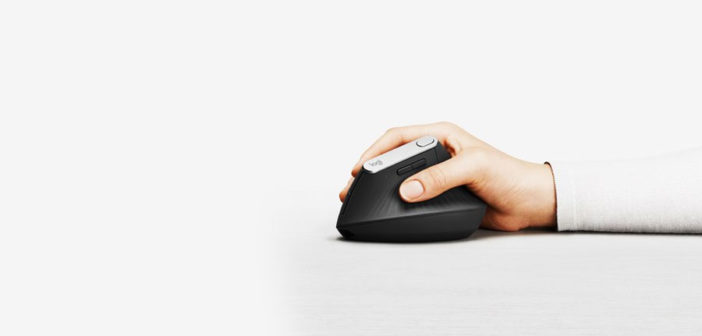IF YOU THINK of ergonomic mice at all, it’s probably the same way you think of, say, mentholated cough drops: functional but not necessarily pleasant. With the MX Vertical, though, Logitech has taken the unusual step of creating a mouse that’s not just better for your body, but pretty darn good-looking.
“I think it’s fair to say that ergonomic products kind of have an image of being a little bit old fashioned, and perhaps borderline clinical, medical. Certainly the ones you encounter commonly have that vibe,” says Nick Jinkinson, Logitech’s head of industrial design for creativity and productivity. “We wanted to get past that image.”
The MX Vertical, which went on sale this week, succeeds. It looks like a wave and feels like a handshake, a place to rest your fingers and palm for hours without overly taxing your wrist. And like so many ergonomic issues, it required careful balance to resolve.
“Really early on in the project, we looked at shapes which were very monolithic, almost. Very simple,” says Jinkinson. An early prototype, called T2 internally, looked something like a cooling station; the “T” stands for “tower.” “It was almost too vertical,” Jinkinson says. “You’d feel like your thumb was slipping down, or slipping off the product.”
In truth, the monolithic design also likely would have undermined Logitech’s ergonomic goals as well. “There is a fundamental problem with how people grasp vertical mouse designs, because these typically place the hand in a wrist extended posture greater than 25 degrees, which increases compression of the median nerve in the wrist,” says Alan Hedge, an ergonomist at Cornell University and program chair of the 2018 National Ergonomics Conference.
What Hedge and his colleagues found, in a 2010 study of ergonomic mice, was that truly effective mice put hands not straight up but at a slant. Which the MX Vertical, despite its name, does, resting the hand at a 57 degree angle. A two-week usability study that the company conducted with ergonomics-focused consulting firm VSI, in fact, showed that participants actually experienced a decrease in wrist extension relative to the mice they had used previously. And users showed 10 percent less muscular activity—a key metric in the mouse ergonomics game—versus a regular mouse.
Show of Hands
The $100 MX Vertical also stands out for embellishments that aren’t strictly ergonomic. The majority of the surface is a soft-feel rubber, which envelops a hard plastic layer inside for rigidity. Again, the theme of balance emerges: It has to be hard enough to be durable, but yield enough to make it pleasantly grippy. In this case, Logitech added a ripple texture to give its big, unusual mouse a little personality, and a pleasant grasp.
“Dialing in those rubbers is a constant thing,” says Jinkinson. “The fundamental material is not unique to this product. But this combination of hardness and texture we put on the surface are unique to this product.”
Despite the emphasis on design, Jinkinson says, no decision was made without scientific input, hooking users up to sensors along the way to measure muscle activation and upper body kinematics, or the angles of how you’re rotating your wrist and arm. “The rule of thumb there is that the most natural position is better,” says Jinkinson. “That’s where we wanted to get to, or as close as we can.”

Logitech also paired the MX Vertical shape with a high-resolution, 4,000 dpi sensor, which dictates the mouse’s sensitivity; the higher the dpi, the further the cursor will move with each nudge. (By contrast, Apple’s Magic Mouse has a dpi of 1,300.) That has ergonomic implications as well. Your on-display arrow travels more with less effort, meaning your hand moves less in the course of a day. For those occasions when you’d prefer a more fine-tuned mousing experience, the MX Vertical’s programmable top button toggles resolution by default, which essentially means you can switch between zippy and low impact and slow, smooth, and accurate with a single tap.
“It all has to do with the cumulative effective of using a mouse or a keyboard over time. These tiny movements that we make, even though they are insignificant compared with sprinting 100 meters or something, the truth is that many of us these days sit at our desks seven, eight hours a day. Those micro-movements eventually add up, and can create quite some problems for people,” says Jinkinson.
All in the Balance
Two caveats, both minor. First, the MX Vertical exists only for right-handers at the moment, with no real plans to invest in a left-handed version. Statistically speaking, that should only upset to a small number of you. Still, for the southpaws, it stings.
And second, the MX Vertical is not the absolutely perfect ergonomic shape. Logitech will tell you that as well. But it may be as close as you can get, while still having a mouse that you don’t mind looking at. Which really does matter, given how much time we all spend with our computers.
“The truth is that it’s always a balance between the absolute ergonomic driven view of the world, which is you make no compromise at all, and more of a kind of realistic position, which is in fact people still want to have desirable products, they don’t want to feel stigmatized,” says Jinkinson. “If we made a mouse that was really, really strange looking, and borderline ugly, we’re not doing anyone any favors, because chances are people wouldn’t buy into that.”
But a mouse that looks like a Matrix mollusk and turns convention quite literally on its head? That demands your attention, ergonomic or otherwise.
–
This article first appeared in www.wired.com
Seeking to build and grow your brand using the force of consumer insight, strategic foresight, creative disruption and technology prowess? Talk to us at +9714 3867728 or mail: info@groupisd.com or visit www.groupisd.com




